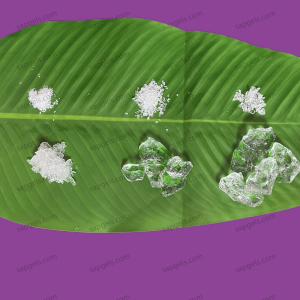Potassium polyacrylate is renowned for its excellent water retention properties and is utilized in various agricultural and environmental applications to enhance soil moisture and crop productivity. Despite sharing the same primary component, variations in raw materials and processing methods lead to distinct functionalities for different uses.

1. Soil Moisture Retention Agent
Application:
- Primary Use: Used in crop planting and transplantation.
- Mechanism: Repeatedly absorbs and releases water in the soil, creating a “micro-reservoir” around the crop roots, ensuring adequate moisture.
Benefits:
- Water Savings: Can reduce irrigation water usage by up to 45%, effectively saving about one-third of the water typically used in agricultural practices.
- Increased Yield: Boosts crop growth and productivity, with certain cases showing yield increases up to 65%.
- Transplant Survival Rate: Enhances transplant success rates to approximately 96%.
- Fertilizer Efficiency: Increases basal fertilizer utilization by 32-48% and water-soluble fertilizer utilization by 32-62%.
- Labor Cost Reduction: Reduces the frequency of irrigation and fertilization, potentially saving up to 45% in labor costs.
- Environmental Friendliness: Fully degradable in soil, ensuring no pollution.
2. Saline-Alkali Resistant Water Retention Agent
Application:
- Primary Use: Specially designed for use in saline-alkali soil conditions.
Benefits:
- Salt-Alkali Resistance: Contains factors that counteract salinity, allowing it to absorb and release water in saline soils, enabling plants to access water more easily from the agent than from the saline soil.
- Fertilizer Efficiency: Absorbs soil nutrients during the water absorption process, promoting crop growth in saline-alkali soils.
- Soil Structure Improvement: Significantly enhances soil structure, reduces compaction, and improves water retention and nutrient utilization, thereby increasing crop yield and quality.
3. Water Retention and Disintegration Agent
Application:
- Primary Use: Used for granulation of organic and bio-organic fertilizers (suitable for various granulation methods such as disc, drum, and extrusion).
Benefits:
- Enhanced Disintegration: Speeds up the breakdown of fertilizer granules, improving nutrient release speed and efficiency by 32-62%.
- Water and Nutrient Retention: Provides a stable supply of water and nutrients for crops.
- Improved Granule Quality: Results in smoother, more uniform fertilizer granules.
- Soil Loosening: Expands over twice its size, enhancing soil permeability and reducing compaction.
- Environmental Safety: Biodegradable in soil, ensuring it is safe for the environment.
4. Coated Water Retention Agent
Application:
- Primary Use: Used for seed coating, a technique widely applied in agriculture.
Benefits:
- Sustained Moisture Supply: Absorbs and stores large amounts of water, gradually releasing it to seeds during dry conditions, improving germination and seedling survival rates.
- Improved Seed Environment: Maintains a moist environment around seeds, promoting germination, especially in areas with dry conditions or uneven rainfall.
- Slow Release of Fertilizers and Pesticides: Can be combined with fertilizers and pesticides, acting as a slow-release carrier, which gradually releases nutrients and protection agents to seeds and seedlings, increasing efficiency and reducing waste.
- Enhanced Seed Quality: Coating smoothens and regulates seed surfaces, improving sowing performance and precision, aiding in mechanized sowing and operational efficiency.
- Seed Protection: Provides physical protection against mechanical damage and pests, improving seed storage and transport stability.

